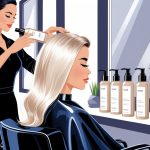New Hair Color Formulas Secretly Reducing Salon Visits for Professionals
Professional Techniques for Stunning, Salon-Quality Color
Caffeine’s barely kicked in and I’m already touching up roots for the third time this quarter. Nobody talks about how one dumb mixing mistake or a lazy brush stroke can mean three extra weeks between appointments—or, you know, color literally melting down the drain after one wash.
Mixing Ratios for Optimal Results
Ignoring ratios? Rookie move. A rep once whipped out a mixing chart and treated it like the Ten Commandments. The difference between 1:1 and 1:2 (color to developer, by weight, not volume—please) is the difference between flat and wow. Salon-grade glossing depends on this.
I’ve tripped over the scale more than once because “eyeballing” isn’t a real skill, not for pros. Demi-permanent formulas need those ratios on point to refresh faded tones without frying ends or causing random bands. Too much developer? You get watery, weak color. Too little? Pigment won’t wake up. No pro just wings it, not with ammonia-free glosses.
If box dye could promise consistency, I’d retire. But, weirdly, some new pro glosses really do last 24 washes if you mix them right—my regulars never believe me until they see their roots. Honestly, longevity comes from those nerdy ratios, not some magical stylist touch.
Application Methods for Vibrant Color
People who slap on color, skip sections, and hope for the best—what are they expecting? Patchwork hair? I’ve seen better ombré in middle school yearbooks. A pro goes section by section, roots to ends if needed, gloved up and focused. Saturation lines make or break the result.
Outgrowth blending isn’t just salon gossip—it’s why efficient balayage doesn’t need panic touch-ups. Feathering and smudging at the roots keep transitions soft, color vibrant for weeks. Open air paints only work if you’re methodical.
My tip: thin, flat slices, not twisted, and don’t overload the brush. Wet applications? Usually dilute pigment more than you’d expect, so I avoid unless the formula’s built for it. You can literally see less regrowth when you do it right, and clients love to brag about pushing out their salon visits… or just send me memes about it.
Top Professional Hair Color Brands Leading Innovation
Permanent shades that stick for weeks and demi lines that banish brassiness—sometimes I wonder if these formulas are trying to put stylists out of work. It’s weird recommending stuff that means less time in the chair, but if the shine and fade-resistance are real, well, the numbers don’t lie (unless my colleagues are just grumbling to themselves behind the foils).
Wella Professionals and Signature Lines
Colorists argue about everything, but Wella Professionals? No contest. Koleston Perfect and Color Touch just work. Even on hair that’s been fried by home bleach jobs during lockdown, I get consistent results. Try to convince me otherwise.
They hype “ME+ technology” and a 60x drop in allergy risk, which I forget until someone’s grateful I didn’t trigger hives. Gloss stays strong, probably thanks to lipid boosters I can’t pronounce. When someone’s mad about box dye, this is what’s in my bowl. No apologies.
Redken, Schwarzkopf Professional, and Goldwell
Redken’s Shades EQ stains my hands every time—I complain, I still use it. Acidic demi, low ammonia, the cult is real. It’s my go-to for tone correction after someone’s “copper” turns out fire hydrant red.
Schwarzkopf Igora Royal—anyone else mix 6-77 with 0-88 for stubborn gray? Sometimes it lasts longer than my patience. Packaging’s confusing, but I keep buying it because, somehow, vibrancy survives even hard water. Goldwell? Topchic NNs for coverage, Colorance for shine. Professors love their swatch charts. I’ve converted stubborn clients with Elumen for wild colors—don’t ask, it just works.
Emerging Favorites: Pravana, Matrix, Joico, and More
Every so often, a stylist panics when Pravana Vivids turns “lavender haze” into molten pink. Still, it sticks. Celebrity stylists keep emptying tubes for TikTok kids, so I guess it’s not going away.
Matrix SoColor, with that Cera-Oil Complex (oil in a tube, why not?), is all over pro forums. The gray coverage is solid, unless the stars misalign. Joico Color Intensity? It deposits fast—20 minutes, done, unless your client’s a shampoo addict. Paul Mitchell’s cool shades are great too, but ignore porosity and even the best formula will let you down.
Eco-Friendly and Vegan Formulas
Vegan formulas, eco stuff—can’t escape the questions. The IGK Permanent Color Kit with squalane and orchid antioxidants supposedly reduces breakage and boosts shine. Now everyone wants “greener” options while I’m elbow-deep in foils.
Aveda Full Spectrum, the vegan poster child. Semi-natural, plant oils, vivid color—except, weirdly, it hates hard water and I don’t know why. Clients love saying their brand doesn’t dump ammonia down the drain, but honestly, even the best eco lines sometimes flop on gray coverage. Recycling sounds nice; sometimes I just want a cream base that doesn’t smell like salad.
Customized Hair Color Solutions for Every Client

Color formulas are chaos—seriously, who decided “champagne blond” means seven different things at three salons? I’ve watched pros fumble shade guides, desperately trying to keep undertones from going sideways. Every time, someone’s devastated when “soft golden beige” turns pumpkin orange. It’s like nobody’s in charge and we’re all just improvising.
Personalized Color Matches
Honestly, nobody warns you how much of a headache real color matching is. You don’t just grab a tube because someone says they want to “feel fresh.” Now, there are brands promising custom color—like, you spill your undertone, every shade you’ve slapped on your head, your heat tool addiction, and poof, a digital colorist whips up your “personalized” formula. Or you’ve got these “pro” tools like FormulaFlow—just punch in porosity, base color, your wildest hair goals, and it spits out a recipe. I swear, if it asked about my mood swings, I wouldn’t even blink.
Table:
| Benefit | Example Solution | Insider Note |
|---|---|---|
| Personalized formulation | Custom online kits | Not every digital match comes out perfect |
| Professional software | Salon-only tools | Still needs actual stylist oversight |
I still have nightmares about the client with five layers of box red over balayage. Only after I logged every dye she’d ever touched did we avoid accidental green hair. These custom formulas do cut down on those “fix my disaster” appointments. Still, I can’t sleep if I forget to thin out the ends or skip clarifying shampoo before color—some things never change.
Options for Color-Treated and Natural Hair
Choices now are wild—works for color junkies and first-timers terrified of change. It’s honestly easier than pretending you know what “just blend my roots like last summer” means. Demi-permanent stuff (see eSalon) gets hyped for less than 25% gray; it sits on top, fades out, never lightens. Permanent color? That’s a whole trap. One slip and you’re stuck with clarifying shampoo and deep conditioners for weeks.
There’s this myth that demi blends grow-outs perfectly. Not true. I’ve seen so many patch tests on roommates, even “virgin” hair ends up with weird bands. Stylists are over chasing old formulas—now, software keeps tabs, tracks pigment, even yells when you’re running low. CLICS does all that. Meanwhile, I can’t even sync my own calendar. Maybe the robots are the real heroes now.



